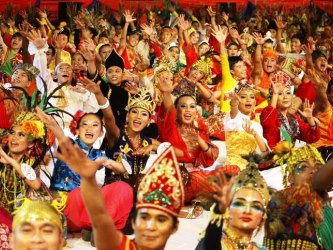Cultural and Peoples

Having had an interesting past and being a part of the international spice route many hundreds of years ago, Malaysia has turned into a mosaic of cultures. Everything from its people to its architecture reflect a colourful heritage and an amalgamated culture. To understand Malaysian culture, you must first get to know its people.
DISCOVER A LAND OF INTRIGUING DIVERSITY
Malays, Chinese, Indians and many other ethnic groups have lived together in
Malaysia for generations. All these cultures have influenced each other,
creating a truly Malaysian culture.
The largest ethnic groups in Malaysia are the Malays, Chinese and Indians. In
Sabah and Sarawak, there are a myriad of indigenous ethnic groups with their own
unique culture and heritage.
Malay
Today, the Malays, Malaysia's largest ethnic group, make up more than 50% of the
population. In Malaysia, the term Malay refers to a person who practices Islam
and Malay traditions, speaks the Malay language and whose ancestors are Malays.
Their conversion to Islam from Hinduism and Theravada Buddhism began in the
1400s, largely influenced by the decision of the royal court of Melaka. The
Malays are known for their gentle mannerisms and rich arts heritage.
Chinese
The second largest ethnic group, the Malaysian Chinese form about 25% of the
population. Mostly descendents of Chinese immigrants during the 19th century,
the Chinese are known for their diligence and keen business sense. The three
sub-groups who speak a different dialect of the Chinese language are the Hokkien
who live predominantly on the northern island of Penang; the Cantonese who live
predominantly in the capital city Kuala Lumpur; and the Mandarin-speaking group
who live predominantly in the southern state of Johor.
Indian
The smallest of three main ethnic groups, the Malaysian Indians form about 10%
of the population. Most are descendants of Tamil-speaking South Indian
immigrants who came to the country during the British colonial rule. Lured by
the prospect of breaking out of the Indian caste system, they came to Malaysia
to build a better life. Predominantly Hindus, they brought with them their
colourful culture such as ornate temples, spicy cuisine and exquisite sarees.
INDIGENOUS ETHNIC GROUPS
Orang Asli
Orang Asli is a general term used for any indigenous groups that are found in
Peninsular Malaysia. They are divided into three main tribal groups: Negrito,
Senoi and Proto-Malay. The Negrito usually live in the north, the Senoi in the
middle and the Proto-Malay in the south. Each group or sub-group has its own
language and culture. Some are fishermen, some farmers and some are
semi-nomadic.
SARAWAK
Collectively known as the Dayaks, the Iban, Bidayuh and Orang Ulu are the major
ethnic groups in the state of Sarawak. Dayak, which means upstream or inland, is
used as a blanket term by the Islamic coastal population for over 200 tribal
groups. Typically, they live in longhouses, traditional community homes that can
house 20 to 100 families.
Iban
The largest of Sarawak's ethnic groups, the Ibans form 30% of the state's
population. Sometimes erroneously referred to as the Sea Dayaks because of their
skill with boats, they are actually an upriver tribe from the heart of
Kalimantan. In the past, they were a fearsome warrior race renowned for
headhunting and piracy. Traditionally, they worship a triumvirate of gods under
the authority of Singalang Burung, the bird-god of war. Although now mostly
Christians, many traditional customs are still practised.
Bidayuh
Peace-loving and easy-going, the gentle Bidayuh of Sarawak are famous for their
hospitality and tuak or rice wine. Making their homes in Sarawak's mountainous
regions, they are mostly farmers and hunters. In their past headhunting days,
their prized skulls were stored in a 'baruk' a roundhouse that rises about 1.5
metres above the ground. Originally animists, now most of them have converted to
Christianity.
Orang Ulu
Also known as upriver tribes of Sarawak. Forming roughly 5.5% of Sarawak's
population, there are over 100,000 different Orang Ulu tribes. Arguably Borneo's
most artistic people, their large longhouses are ornately decorated with murals
and superb woodcarvings; their utensils are embellished with intricate beadwork;
and aristocratic ladies cover their bodies with finely detailed tattoos.
SABAH
The largest indigenous ethnic groups of Sabah's population are the Kadazan Dusun,
the Bajau and the Murut.
Kadazan Dusun
The largest ethnic group of Sabah, the Kadazan Dusuns form about 30% of the
state's population. Actually consisting of two tribes; the Kadazan and the Dusun,
they were grouped together as they both share the same language and culture.
However, the Kadazan are mainly inhabitants of flat valley deltas, which are
conducive to paddy field farming, while the Dusun traditionally lived in the
hilly and mountainous regions of interior Sabah.
Bajau
The second largest ethnic group in Sabah, the Bajaus make up about 15% of the
state's population. Historically a nomadic sea-faring people that worshipped the
Omboh Dilaut or God of the Sea, they are sometimes referred to as the Sea
Gypsies. Those who chose to leave their sea-faring ways became farmers and
cattle-breeders. These land Bajaus are nicknamed 'Cowboys of the East' in
tribute to their impressive equestrian skills, which are publicly displayed in
the annual Tamu Besar festival at Kota Belud.
Murut
The third largest ethnic group in Sabah the Muruts make up about 3% of the
state's population. Traditionally inhabiting the northern inland regions of
Borneo, they were the last of Sabah's ethnic groups to renounce headhunting.
Now, they are mostly shifting cultivators of hill paddy and tapioca,
supplementing their diet with blowpipe hunting and fishing. Like most indigenous
tribes in Sabah, their traditional clothing is decorated with distinctive
beadwork.